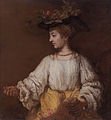Flora (Rembrandt, Hermitage)
| Flora | |
|---|---|
| Saskia as Flora | |
 | |
| Artist | Rembrandt |
| Year | 1634 |
| Medium | oil paint, canvas |
| Dimensions | 125 cm (49 in) × 101 cm (40 in) |
| Location | Hermitage hall 254 - Rembrandt hall |
| Collection | Hermitage Museum |
| Identifiers | RKDimages ID: 22571 Bildindex der Kunst und Architektur ID: 30129361 |
Flora or Saskia as Flora (
Description
The life-size quarter-length work was painted in Amsterdam, during a period when the young artist was experiencing early success. He married Saskia in June 1634, and he made several paintings of her in the guise of characters from ancient myth, similar to his other character portraits (tronies). This work is thought to depict Saskia as Flora, Roman goddess of spring and flowers. She is standing in a grotto, looking towards the viewer, swathed in an extravagant and exotic costume of silk and satin with silver embroidery, with long hanging sleeves and a blue mantle, and wears a large pearl earring. She has a floral headdress over her long hair, including a multicoloured "broken" tulip. She is also carrying a staff also decorated with leaves and flowers.
The painting measures 125 cm × 101 cm (49 in × 40 in). It is signed and dated below Flora's right hand, "Rembrandt f (…) 34".
Rembrandt's paintings of Flora may have drawn some inspiration from the painting of
Rembrandt also painted Saskia as other female figures from ancient myth, including Bellona (1633, Metropolitan Museum of Art) and Minerva (1635, The Leiden Collection of Thomas Kaplan and Daphne Recanati Kaplan).
-
Bellona, 1633, Metropolitan Museum of Art
-
Minerva, 1635, The Leiden Collection
-
Saskia van Uylenburgh in Arcadian Costume, 1635, National Gallery, London
-
Saskia with a Red Flower] (aka Saskia as Flora), 1641, Staatliche Kunstsammlungen Dresden
-
Flora, 1654, Metropolitan Museum of Art
Provenance
The early provenance of the painting is not clear. It was put up for sale in Amsterdam in 1770 from the estate of
It was catalogued by Cornelis Hofstede de Groot in 1915, who recorded that it was sometimes wrongly called The Jewish Bride.[1]
See also
Notes
- ^ Entry 206 for ''Flora in Hofstede de Groot, 1915
References
- Michael Kitson: Rembrandt. Phaidon Press Inc., New York City 2007. ISBN 9780714827438, page 50
- Flora in the RKD
- Flora, in the Hermitage
 Media related to Flora by Rembrandt ("Hermitage") at Wikimedia Commons
Media related to Flora by Rembrandt ("Hermitage") at Wikimedia Commons




![Saskia with a Red Flower [it; pl] (aka Saskia as Flora), 1641, Staatliche Kunstsammlungen Dresden](http://upload.wikimedia.org/wikipedia/commons/thumb/7/7e/Rembrandt_Harmensz._van_Rijn_087.jpg/100px-Rembrandt_Harmensz._van_Rijn_087.jpg)
